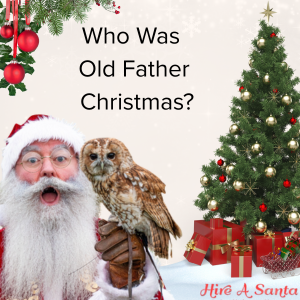Who Was Old Father Christmas?
Father Christmas was originally a symbol of fun, food, and festive cheer—not gifts! Long before he was handing out presents, he was more about adult celebrations during the Christmas season in medieval and Tudor England.
In the 15th century, a character named Sir Christëmas appeared in songs, spreading joy and encouraging people to feast and be merry. During the Tudor and Stuart eras, people celebrated Christmas with characters like Captain Christmas and the Lords of Misrule—who were all about laughter, games, and indulgence. But back then, no one called them “Father Christmas,” and they weren’t always portrayed as elderly.
The English Origins of Father Christmas
The first time Father Christmas was clearly shown as a jolly old man with a beard was in 1616, thanks to playwright Ben Jonson. In his festive play Christmas, His Masque, he introduced “Old Father Christmas,” who came with symbolic children like Mince Pie and Wassail—representing different parts of the holiday.
But this version of Father Christmas wasn’t about children or gifts. He was more about keeping tradition alive—especially during tough times like the English Civil War when Puritans banned Christmas altogether in 1647.
People rebelled, and pamphlets began to show Father Christmas as a figure of joy and protest. A famous example was the 1652 publication A Vindication of Christmas, where he represented the fight to bring back Christmas fun, food, and singing.
The History of Father Christmas
In the 1800s, everything started to change. The Victorians reinvented Christmas—and with it, Father Christmas.
He became less about parties and more about family, children, and charity. Stories like Charles Dickens’ A Christmas Carol helped shape this new image. His character, the Ghost of Christmas Present, was a big, cheerful man wearing a crown of holly—very similar to the Father Christmas we know today.
Illustrations also played a big role. Artists started showing Father Christmas as kind and generous, visiting homes and spreading joy.
 So Where Did Santa Claus Come From?
So Where Did Santa Claus Come From?
While England had Father Christmas, Europe had Saint Nicholas, a kind 4th-century bishop famous for secretly giving gifts. Over time, he became Sinterklaas in the Netherlands, who would travel by horse and boat, leave gifts in shoes, and even come down chimneys. Sinterklaas Day was (and still is) celebrated on December 6th.
Dutch settlers brought these Sinterklaas traditions to America in the 1600s. There, a whole new character started to take shape.
Writers like:
Washington Irving (1809), and
Clement C. Moore (1823), who wrote ‘Twas the Night Before Christmas
…helped shape a new figure—Santa Claus. He was a jolly man, riding in a sleigh pulled by reindeer, delivering presents to children on Christmas Eve.
In the late 1800s, artist Thomas Nast gave Santa his iconic look: red suit, fur trim, big belt, and a North Pole workshop filled with elves. This version quickly spread through American media, books, and advertising—and later made its way back to Britain.
By the 1880s, Santa Claus and Father Christmas had blended into one. Today, they are basically the same person!
FAQ: Santa Hire
Looking to hire Santa Claus for your event or party? Here are some of the most common questions people ask:
Can I hire a real Santa?
Yes! You can hire professional Santas who are trained performers. They come in full costume and act just like the real thing—jolly laugh and all.
How much does it cost to hire Santa?
It depends on location and how long you want him. On average, expect to pay £80–£300 per hour. Some Santas offer packages for events, home visits, or photo sessions.
Can Santa visit my home?
Yes, absolutely! Many families hire Santa for home visits, especially during the run-up to Christmas. It makes for a magical memory.
Does Santa bring gifts?
Some Santas will hand out gifts if you provide them in advance. Others may bring their own small goodies or sweets—just ask when booking.
Can I take photos with Santa?
Definitely! Most Santa visits include photo opportunities, perfect for keepsakes or Christmas cards.
From Folklore to Fireplace Visits: Santa’s Timeless Journey
Santa Claus—whether you call him Father Christmas, Saint Nick, or Kris Kringle—is a beloved part of Christmas today. But his story is rich with history, culture, and transformation.
From the feasting figure of Old Father Christmas in England to the magical, gift-giving Santa Claus we know today, it’s clear that both British and American traditions shaped him into the holiday icon he has become.
So next time you see Santa in his red suit, just remember: he’s got a long, merry history behind that “Ho Ho Ho!”



